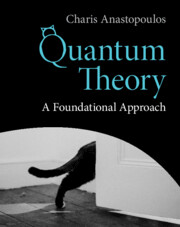Refine listing
Actions for selected content:
9096 results in Communications, Signal Processing and Information Theory
3 - Model-Based Reconstruction with Learning: From Unsupervised to Supervised and Beyond
- from Part I - Theory of Deep Learning for Image Reconstruction
-
-
- Book:
- Deep Learning for Biomedical Image Reconstruction
- Published online:
- 15 September 2023
- Print publication:
- 12 October 2023, pp 28-52
-
- Chapter
- Export citation
6 - Deep Learning in CT Reconstruction: Bringing the Measured Data to Tasks
- from Part II - Deep-Learning Architecture for Various Imaging Architectures
-
-
- Book:
- Deep Learning for Biomedical Image Reconstruction
- Published online:
- 15 September 2023
- Print publication:
- 12 October 2023, pp 114-165
-
- Chapter
- Export citation
Part III - Generative Models for Biomedical Imaging
-
- Book:
- Deep Learning for Biomedical Image Reconstruction
- Published online:
- 15 September 2023
- Print publication:
- 12 October 2023, pp 277-278
-
- Chapter
- Export citation

Quantum Theory
- A Foundational Approach
-
- Published online:
- 06 October 2023
- Print publication:
- 31 August 2023
-
- Textbook
- Export citation
Part II - Eigensystem
-
- Book:
- Graph Spectra for Complex Networks
- Published online:
- 07 September 2023
- Print publication:
- 21 September 2023, pp 305-306
-
- Chapter
- Export citation
Part I - Spectra of graphs
-
- Book:
- Graph Spectra for Complex Networks
- Published online:
- 07 September 2023
- Print publication:
- 21 September 2023, pp 13-14
-
- Chapter
- Export citation
7 - Density function of the eigenvalues
- from Part I - Spectra of graphs
-
- Book:
- Graph Spectra for Complex Networks
- Published online:
- 07 September 2023
- Print publication:
- 21 September 2023, pp 247-270
-
- Chapter
- Export citation
Symbols
-
- Book:
- Graph Spectra for Complex Networks
- Published online:
- 07 September 2023
- Print publication:
- 21 September 2023, pp xvii-xx
-
- Chapter
- Export citation
1 - Introduction
-
- Book:
- Graph Spectra for Complex Networks
- Published online:
- 07 September 2023
- Print publication:
- 21 September 2023, pp 1-12
-
- Chapter
-
- You have access
- Export citation
9 - Topics in linear algebra
- from Part II - Eigensystem
-
- Book:
- Graph Spectra for Complex Networks
- Published online:
- 07 September 2023
- Print publication:
- 21 September 2023, pp 307-344
-
- Chapter
- Export citation
Dedication
-
- Book:
- Graph Spectra for Complex Networks
- Published online:
- 07 September 2023
- Print publication:
- 21 September 2023, pp v-vi
-
- Chapter
- Export citation
8 - Spectra of complex networks
- from Part I - Spectra of graphs
-
- Book:
- Graph Spectra for Complex Networks
- Published online:
- 07 September 2023
- Print publication:
- 21 September 2023, pp 271-304
-
- Chapter
- Export citation
Index
-
- Book:
- Graph Spectra for Complex Networks
- Published online:
- 07 September 2023
- Print publication:
- 21 September 2023, pp 513-515
-
- Chapter
- Export citation
11 - Polynomials with real coefficients
- from Part III - Polynomials
-
- Book:
- Graph Spectra for Complex Networks
- Published online:
- 07 September 2023
- Print publication:
- 21 September 2023, pp 401-466
-
- Chapter
- Export citation
Frontmatter
-
- Book:
- Graph Spectra for Complex Networks
- Published online:
- 07 September 2023
- Print publication:
- 21 September 2023, pp i-iv
-
- Chapter
- Export citation
Bibliography
-
- Book:
- Graph Spectra for Complex Networks
- Published online:
- 07 September 2023
- Print publication:
- 21 September 2023, pp 503-512
-
- Chapter
- Export citation
5 - Effective resistance matrix
- from Part I - Spectra of graphs
-
- Book:
- Graph Spectra for Complex Networks
- Published online:
- 07 September 2023
- Print publication:
- 21 September 2023, pp 175-192
-
- Chapter
- Export citation
Part III - Polynomials
-
- Book:
- Graph Spectra for Complex Networks
- Published online:
- 07 September 2023
- Print publication:
- 21 September 2023, pp 399-400
-
- Chapter
- Export citation
10 - Eigensystem of a matrix
- from Part II - Eigensystem
-
- Book:
- Graph Spectra for Complex Networks
- Published online:
- 07 September 2023
- Print publication:
- 21 September 2023, pp 345-398
-
- Chapter
- Export citation
Preface to the first edition
-
- Book:
- Graph Spectra for Complex Networks
- Published online:
- 07 September 2023
- Print publication:
- 21 September 2023, pp xiii-xv
-
- Chapter
- Export citation
